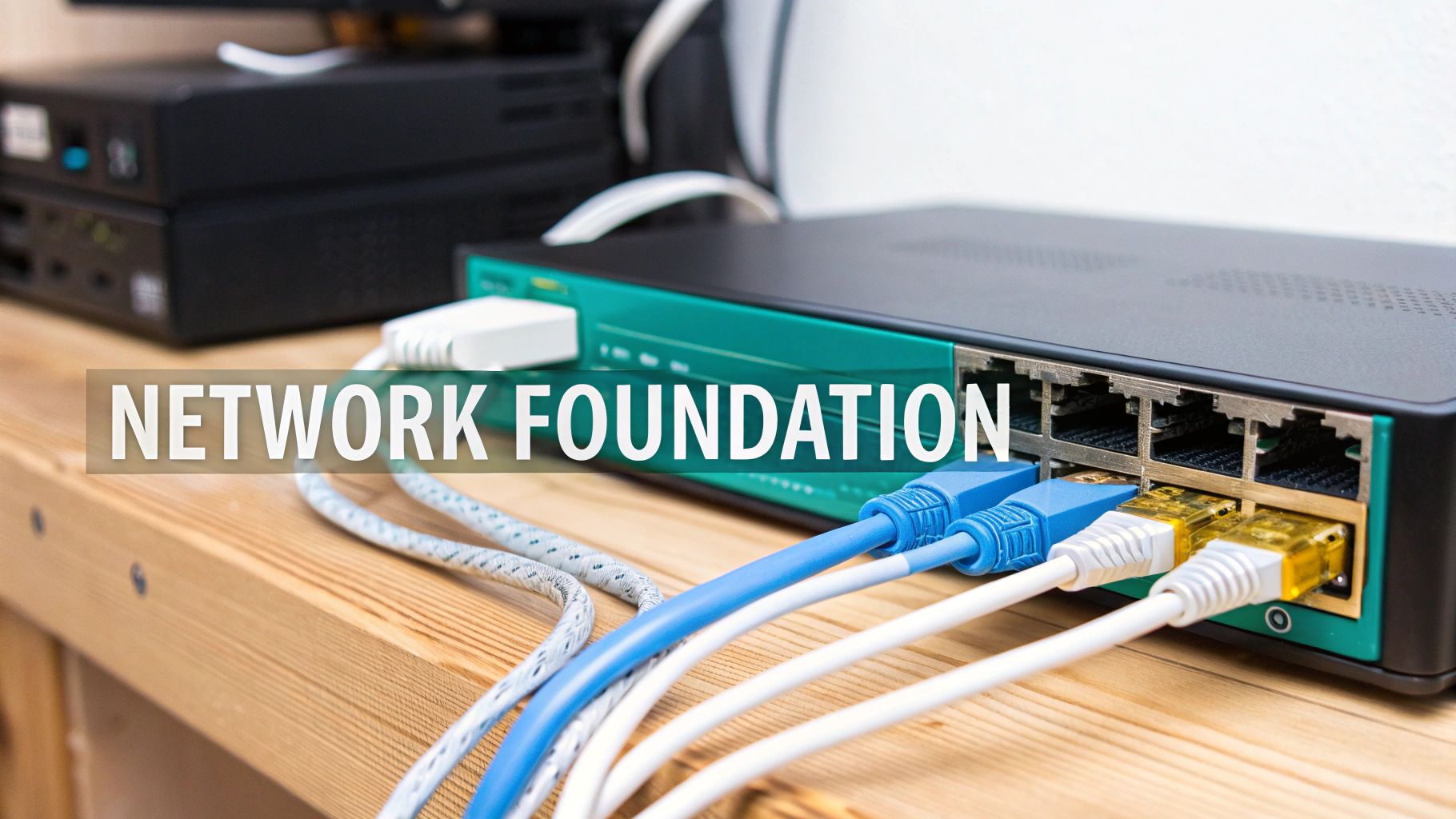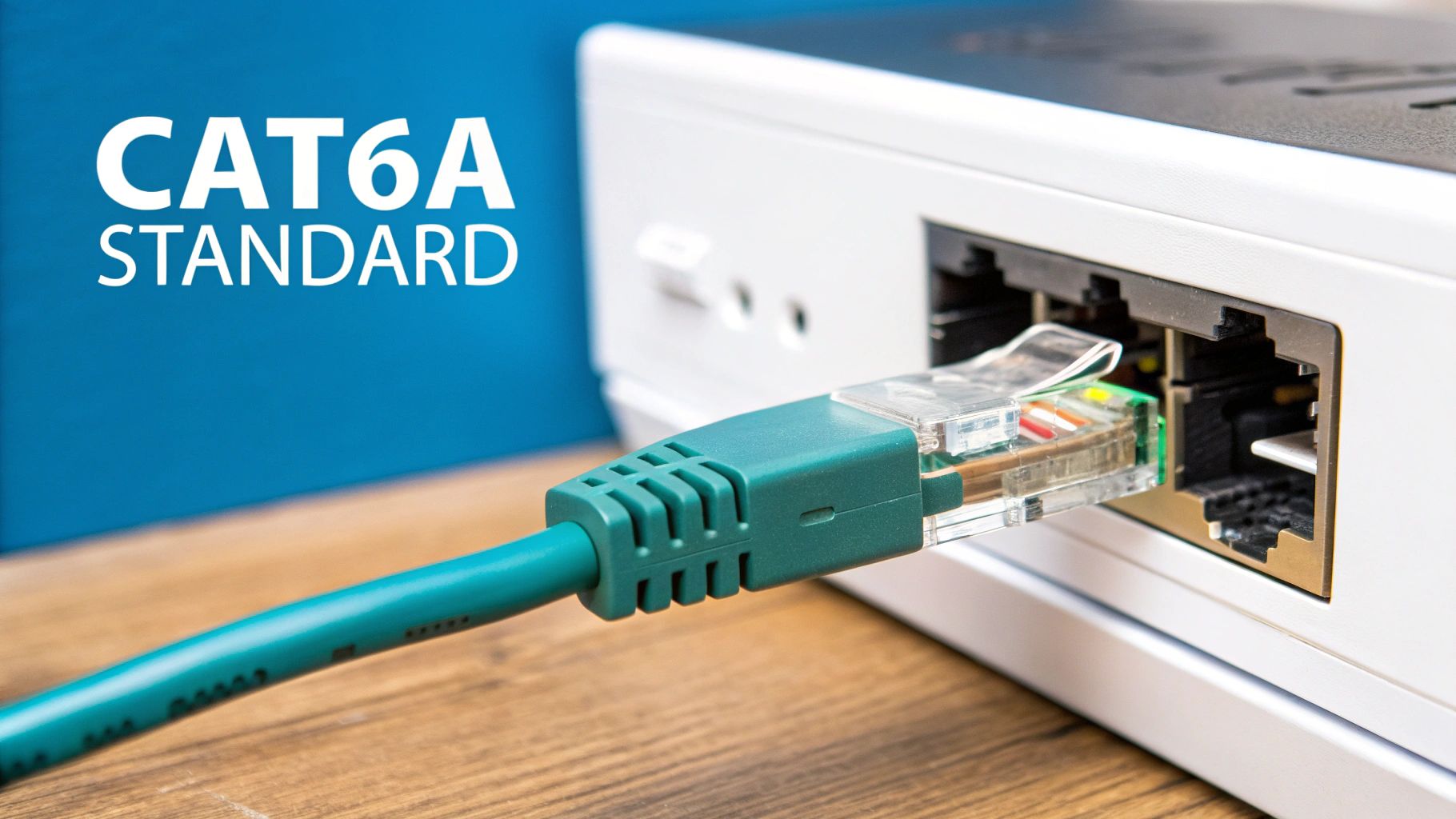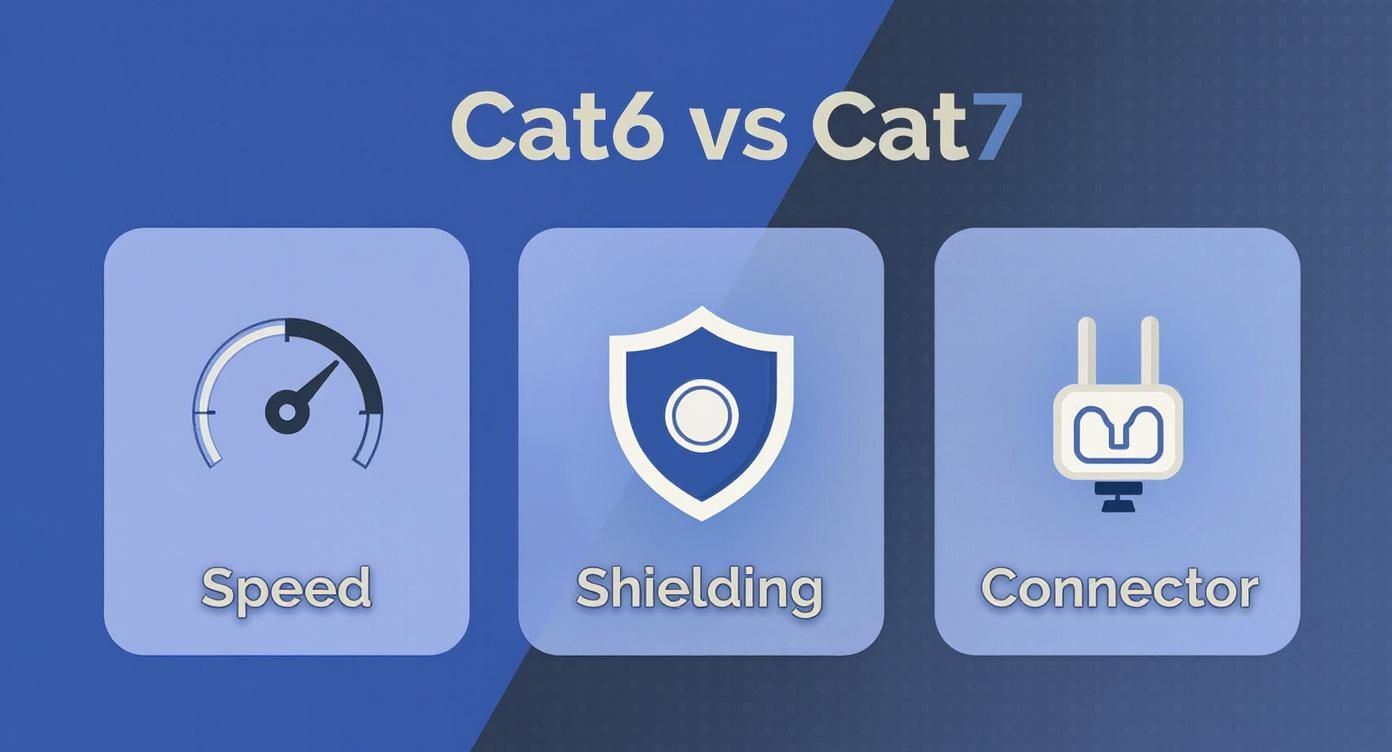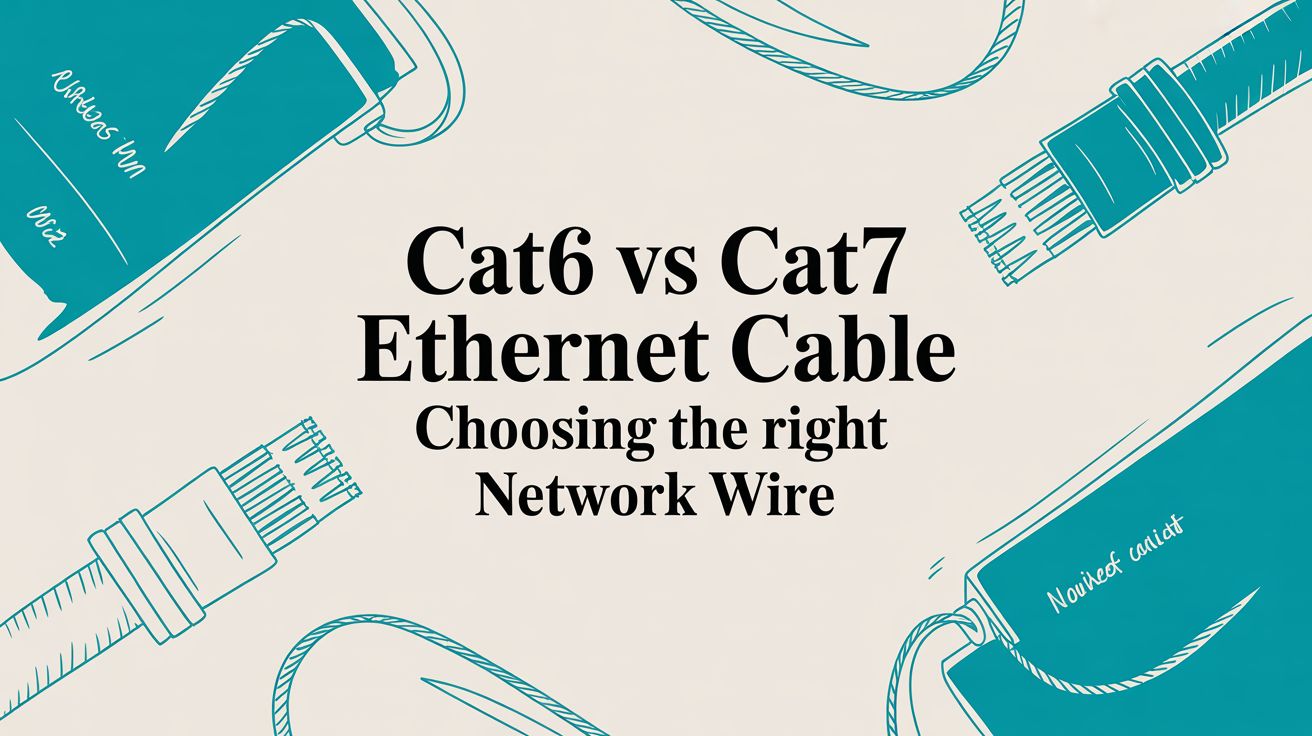When laying the groundwork for a high-performance network, the Cat6 vs Cat7 Ethernet cable debate is one you'll inevitably encounter. As experts in network infrastructure and smart home technology, let us cut straight to the chase: for almost every high-end residential or commercial project we handle, from London to the Costa del Sol, our verdict is clear. Cat6a hits the sweet spot, delivering an unbeatable mix of raw performance, value, and genuine future-readiness.
While Cat7 might look more impressive on a spec sheet, its real-world advantages are often nullified by compatibility headaches and a much higher price tag. Our focus is on delivering innovation and reliability through proven, standards-compliant technology.
Building Your Network Foundation

Here at MTL Smart Solutions, we live and breathe this work. A rock-solid network is the absolute, non-negotiable bedrock for every system we install: seamless smart home automation, crisp AV distribution, and dependable CCTV. Whether we’re designing the network for a sprawling luxury villa in Sotogrande or a multi-storey office in London, our approach is always grounded in meticulous attention to detail and technology that gets the job done right.
Think of the cabling inside your walls as the central nervous system of your property. It dictates how fast your Wi-Fi feels, how clear your security footage is, and how instantly your smart systems respond. Getting this choice right from day one saves a world of pain and costly upgrades down the line, ensuring your infrastructure is ready for whatever technology comes next.
In the UK, Cat6 cables have long been a go-to standard, striking a good balance of performance and cost. Capable of hitting speeds up to 10 Gbps over 55 metres, they’re sufficient for many scenarios. However, our commitment is to engineering solutions tailored to your actual needs for today and tomorrow, rather than just solving today's problem. A brilliantly designed system using the right category of cable will always outperform a poorly planned one that uses an overpowered, incompatible alternative.
For a deeper dive into crafting an exceptional network, take a look at our comprehensive guide on the best home network setup.
Quick Comparison: Cat6 vs Cat7
Let’s break down the key differences in a way that makes sense for your project.
| Feature | Cat6 / Cat6a | Cat7 |
|---|---|---|
| Max Speed | 10 Gbps | 10 Gbps (up to 40 Gbps at <50m) |
| Bandwidth | 250 MHz / 500 MHz (Cat6a) | 600 MHz |
| Connector | Standard RJ45 | Proprietary GG45 / TERA |
| Best For | High-end residential & commercial | Specialised data centre environments |
Ready to build a network that simply works, every single time? Get in touch with MTL Smart Solutions for a professional consultation. We’re the trusted network infrastructure experts in the UK and Costa del Sol.
Cat6 and Cat6a: The Proven Industry Standard
When discussing modern network infrastructure, Cat6 and its enhanced sibling, Cat6a, are the gold standard for any new installation. For years, Cat6 has been the dependable workhorse in countless UK homes and businesses. But at MTL Smart Solutions, our philosophy is to build networks for tomorrow, not just for today. That's why we exclusively specify Cat6a for new projects that demand peak performance and reliability.

It all comes down to the numbers. Standard Cat6 is capable of hitting 10 Gigabits per second (Gbps), but only up to about 55 metres. Beyond that, performance can degrade. Cat6a, on the other hand, confidently delivers that full 10 Gbps all the way up to the maximum channel length of 100 metres. That’s not just a minor improvement; it's a game-changer for today's high-bandwidth smart properties.
Why 10 Gbps at 100 Metres Matters
That extended reach makes Cat6a the only sensible choice for connecting the powerful devices that form the heart of a modern property. We rely on it to build ultra-stable network backbones—or fibre backbones for larger sites—that can effortlessly support:
- High-Performance Wi-Fi: Giving Wi-Fi 6 and new Wi-Fi 7 access points the massive data pipeline they need to operate at full throttle.
- Power over Ethernet (PoE) Switches: Sending both power and high-speed data to demanding devices like advanced CCTV cameras from Hikvision or Ubiquiti.
- 4K and 8K Video Distribution: Providing the unwavering, high-speed connection needed for flawless multi-room AV systems.
At MTL Smart Solutions, we see Cat6a as more than just a cable—it’s the foundation that guarantees every smart system we install will work perfectly. A flawless network is the secret to a flawless smart home or office.
Real-World Applications Across the UK and Spain
We've put this philosophy into practice in projects across both our operational hubs. A perfect example is a recent multi-building fibre upgrade in London, where a Cat6a infrastructure was essential for linking disparate systems into one cohesive, high-speed network.
It's the same story for a luxury villa Wi-Fi and CCTV installation in Estepona. Our team designed and installed a comprehensive Cat6a network that became the rock-solid foundation for everything: a sophisticated home automation system, a multi-camera Hikvision security setup, and seamless Wi-Fi coverage across the entire property. This project showcases how we deliver the same high standards of UK engineering and professionalism to our Spanish clients on the Costa del Sol. Getting these installations right is a craft, as we explore in our guide to elevating your home experience with professional network cabling.
If you’re planning a project and need a network you can truly depend on, contact MTL Smart Solutions today. We can provide a tailored quote for a professional Wi-Fi system design in London or a full network installation across the Costa del Sol.
The Problem with Cat7: More Hype Than Reality
Now, let's address Cat7. On paper, it looks like a beast, and you'd be forgiven for thinking it’s the next logical step up. It supports a frequency of 600 MHz and features heavy-duty S/FTP shielding, where each wire pair is wrapped in foil before the entire bundle is wrapped in a tough outer braid. It's built like a tank to fend off electrical interference.
So, What's the Catch with Cat7?
This is where theory collides with reality. At MTL Smart Solutions, our reputation is built on delivering systems that work flawlessly for our clients, day in and day out. This is where Cat7 consistently falls short for residential and commercial applications. The impressive specifications simply don't deliver a noticeable real-world performance boost for these environments.
The real spanner in the works? The connectors.
The Connector Conundrum
Cat7 was not designed for the ubiquitous RJ45 connector found on every router, switch, and laptop. The official standard requires a different, proprietary connector – either the GG45 or TERA type. This is a critical point.
This single design choice creates a significant headache. You may find cables marketed as "Cat7" with standard RJ45 ends, but here's the secret: they are not truly Cat7 compliant. The moment you terminate that cable with an RJ45 connector, you bottleneck its performance right back down to Cat6a levels. All that extra cost and shielding become redundant.
From years of experience, introducing non-standard equipment into a network is an invitation for trouble. It creates unnecessary complexity and potential points of failure. That’s why we stick to proven, standards-compliant technology from trusted partners like Ubiquiti and Ruijie – it guarantees rock-solid reliability, whether we’re deploying a CCTV installation in Estepona or a smart home in London.
This connector issue is the primary reason Cat7 never achieved widespread adoption. Certified in 2002, its non-standard connectors and higher price point made it a non-starter for most projects. It remains a niche product, primarily used in highly specialised data centres. If you want to dig deeper, there are plenty of market insights on this topic that explain its slow adoption.
For our clients who need a powerful network – whether for a smart home installation in Spain or a Wi-Fi system design in London – Cat6a delivers all the speed and reliability they will ever need, without any of the compatibility nightmares.
Thinking about a new project? If you want expert advice on building a network that’s both future-proof and practical, book a consultation with our team today. We bring the same high standards of UK engineering to our clients across the UK and down on the Costa del Sol.
A Head-to-Head Showdown: Cat6 vs Cat7 Specs
To truly understand the Cat6 vs Cat7 debate, we need to cut through the marketing fluff and look at the technical specifications that actually matter. This isn't about picking the cable with the bigger number; it's about understanding what these figures mean for your network's real-world performance and reliability.
This is critical whether we're designing a seamless smart home network in Spain or a robust commercial Wi-Fi system in London. The key differences boil down to three things: bandwidth, shielding, and the connectors you use. Each plays a huge role in data transmission and compatibility with your hardware, including switches and access points from top brands like Hikvision, Ubiquiti, or Ruijie.
Bandwidth and Speed
Here’s the bottom line: both Cat6a and Cat7 can handle speeds of 10 Gbps over a full 100-metre run. The real difference is the maximum frequency, or bandwidth.
- Cat6a: This industry workhorse operates at a bandwidth of 500 MHz. This is more than enough capacity to handle a 10 Gbps data rate without breaking a sweat, delivering a stable, high-speed connection perfect for demanding applications like streaming 4K video or powering high-performance Wi-Fi.
- Cat7: This cable pushes the bandwidth up to 600 MHz. While the number looks better on paper, the extra headroom provides absolutely no real-world speed boost on a 10 Gbps network. You are essentially paying for extra capacity that current hardware cannot utilise.
Want to see how we build systems that make the most of these speeds? Check out our other articles on network infrastructure.
Shielding and Connectors: The Real Deal-Breakers
This is where the practical differences become most apparent. Shielding protects the cable's signal from external electrical "noise," while the connector type dictates whether you can even plug it into your devices.
At MTL Smart Solutions, our reputation is built on designing and installing integrated systems that are bulletproof from end to end. Introducing non-standard parts, like Cat7's GG45 connector, creates a weak link in the chain. It’s a potential point of failure that can compromise the integrity of the entire network we’ve so carefully built.
The table below lays out these crucial differences. It clearly shows why Cat6a is our go-to recommendation for almost every single project, from a luxury villa's Wi-Fi and CCTV setup in Estepona to a multi-building fibre upgrade in London.
Practical Comparison of Cat6, Cat6a, and Cat7 Cables
Here’s a simple breakdown of the features that truly matter when choosing the right cable for a smart home or commercial project. Notice how Cat6a hits the perfect balance of performance and compatibility.
| Feature | Cat6 | Cat6a | Cat7 |
|---|---|---|---|
| Max Speed | 1 Gbps (up to 100m) / 10 Gbps (up to 55m) | 10 Gbps (up to 100m) | 10 Gbps (up to 100m) |
| Bandwidth | 250 MHz | 500 MHz | 600 MHz |
| Standard Connector | RJ45 (Universally compatible) | RJ45 (Universally compatible) | GG45 / TERA (Proprietary, non-standard) |
| Shielding | UTP (Unshielded) or F/UTP (Shielded) | F/UTP (Shielded is standard for 10Gbps) | S/FTP (Individually shielded pairs + overall shield) |
| MTL Recommendation | Great for most homes & small offices | The professional standard for 99% of projects | Only for highly niche industrial/data centre use |
As you can see, Cat6a provides the full 10 Gbps performance over the standard 100-metre distance while using the universal RJ45 connector that all your devices already have. Cat7, despite its impressive shielding, introduces a compatibility headache without offering a tangible speed advantage.
Ready to build your project on the right foundation? Contact MTL Smart Solutions for a tailored quote and get expert advice from network infrastructure experts in the UK and on the Costa del Sol.
Real-World Scenarios: Choosing the Right Cable for the Job
Theory is valuable, but it's in real-world application where network design truly proves its worth. At MTL Smart Solutions, our advice is forged from years of hands-on experience in diverse environments, from historic London townhouses to sleek, modern villas in Sotogrande and Manilva.
Knowing which cable to use where is key to building a network that’s not just powerful, but also cost-effective. It’s about matching the right tool to the right task with precision and foresight.
When Standard Cat6 is the Sensible Choice
For many day-to-day applications, standard Cat6 cable remains a brilliant and sensible option. It offers more than enough performance for devices that simply don't require a 10 Gbps connection.
We often run Cat6 for:
- Everyday Desktop PCs: For typical office work, web browsing, and video calls, Cat6 handles 1 Gbps connectivity perfectly.
- Printers and Scanners: These networked office devices have minimal data demands, making Cat6 a cost-effective fit.
- Low-Demand Smart Home Devices: Components like smart thermostats, lighting hubs, or basic sensors do not need a high-speed data pipe to function flawlessly.
Cat6a: The Professional’s Go-To for High Performance
This is where our expertise as network infrastructure specialists truly shines. For any new build, major renovation, or system where performance and reliability are paramount, we exclusively install Cat6a. Its ability to deliver a blazing 10 Gbps over 100 metres makes it the undisputed champion for any future-ready property.
We recently completed a luxury villa Wi-Fi and CCTV installation in Estepona, and the brief was clear: a bulletproof network for a sophisticated smart home system, multi-room 4K video, and a high-definition Hikvision security setup. Cat6a was the only contender, providing the rock-solid, high-speed backbone needed to ensure every single one of those systems ran flawlessly and reliably.
This infographic lays out the key differences in speed, shielding, and connectors.

As you can see, while Cat7 boasts impressive shielding, its non-standard connector is a significant practical disadvantage compared to the universal RJ45 found on Cat6a.
Where Does Cat7 Fit In? (Hint: Almost Nowhere)
So, is there ever a time and place for Cat7? In our world of high-end residential and commercial projects, the answer is a resounding no. Its use case is incredibly niche, typically reserved for heavy industrial settings or data centres battling extreme electromagnetic interference.
For a Wi-Fi system design in London or a sophisticated smart home installation in Spain, Cat7’s proprietary connectors and negligible real-world benefits make it an impractical and often troublesome choice. Our deep experience in business networking consistently points to Cat6a as the far superior solution.
Ready to discuss what your project truly needs? Get in touch with MTL Smart Solutions for a tailored quote, and let our experts design the perfect network for your property, whether it’s in the UK or on the Costa del Sol.
Our Verdict: Why We Almost Always Recommend Cat6a
After diving deep into the Cat6 vs Cat7 debate, our professional conclusion is straightforward. For 99% of the high-end homes and commercial spaces we work on, Cat6a is the hands-down winner for building a network that’s ready for the future.
It perfectly balances raw power with real-world practicality. You get the full 10 Gbps speeds that today’s technology demands, delivered reliably over the full 100-metre distance that industry standards are built around. Most importantly, it uses the universal RJ45 connector, ensuring seamless compatibility with everything you already own and everything you're likely to buy.
The Foundation for Everything Smart
Think of your network cabling as the foundation of a house. If it’s weak, everything you build on top of it will be unreliable. A professionally planned and installed Cat6a network is the solid bedrock that allows all the exciting technology to shine. It’s what guarantees the flawless performance of the systems we specialise in, such as:
- Smart Home Automation: It ensures your commands for lighting, blinds, and heating happen instantly, without frustrating delays.
- Multi-Room AV: It provides the rock-solid, high-speed connection essential for distributing stunning, buffer-free 4K and 8K video throughout your property.
- Managed Wi-Fi Services: It gives powerful access points from brands like Ubiquiti and Ruijie the huge data pipeline they need to blanket your space in incredible wireless coverage.
We bring the same high standards of UK engineering and meticulous attention to detail to every single project, whether that’s a CCTV installation in Estepona or a complete network overhaul in London. Our entire focus is on innovation, reliability, and building an infrastructure that’s genuinely built to last.
This commitment means a smart home installation in Spain receives the exact same level of professional care as one in the UK. We believe that excellence shouldn't depend on your postcode. The core principles of a brilliant network are universal, as we detail in our articles on professional installation.
Your network is far too important to be an afterthought. It is the central nervous system of your home or business—the key that unlocks the true potential of modern technology.
Ready to build a network you can depend on for years to come? Contact MTL Smart Solutions today to book a consultation and receive a tailored quote from our network infrastructure experts in the UK and on the Costa del Sol.
Got Questions About Ethernet Cabling? We've Got Answers
When it comes to the technical details of your network, a few common questions always arise. As seasoned network infrastructure experts working across the UK and the Costa del Sol, we’ve heard them all. Here are the answers to a couple of the most frequent queries from our clients.
Can I Mix and Match Different Ethernet Cables in My Network?
Absolutely, but it requires a smart, strategic plan—something we do all the time. For instance, on a recent CCTV installation Estepona project, we ran a high-performance Cat6a cable as the main backbone connecting the PoE switch to the Hikvision NVR. Then, for the individual cameras which don't need as much bandwidth, we used standard Cat6. This maintains high performance where it matters most, without overspending.
Just remember, your network's speed is dictated by its slowest component. If you connect a Cat7 patch lead to a Cat6 wall socket, you will only achieve Cat6 speeds. That’s why our Wi-Fi system design London projects always start with a detailed cabling blueprint. We map out precisely which cable goes where to achieve the optimal balance of peak performance and cost-effectiveness.
A professionally designed network isn’t about using the most expensive cable everywhere. It’s about strategically deploying the right cable in the right place to build a balanced, reliable, and seriously fast system from end to end.
Should I Bother Upgrading to Cat8 for My Home or Office?
For almost every high-end home or business we work with, the answer is a resounding no. Cat8 is a specialist cable engineered for immense 40 Gbps speeds. The catch is, it’s designed for extremely short distances (under 30 metres) inside massive data centres.
For a smart home installation in Spain or a typical London office, it's complete overkill. The routers, switches, and computers that can actually use that kind of speed are incredibly rare and prohibitively expensive. A professionally installed Cat6a system will provide all the firepower you could possibly need for years to come, representing a much wiser investment.
Your network is the digital backbone of your property, powering everything from your smart home systems to your business operations. To ensure it’s built to perform, you need an expert touch. For a professional consultation, site visit, or a quote tailored to your project, contact MTL Smart Solutions.





Comments are closed